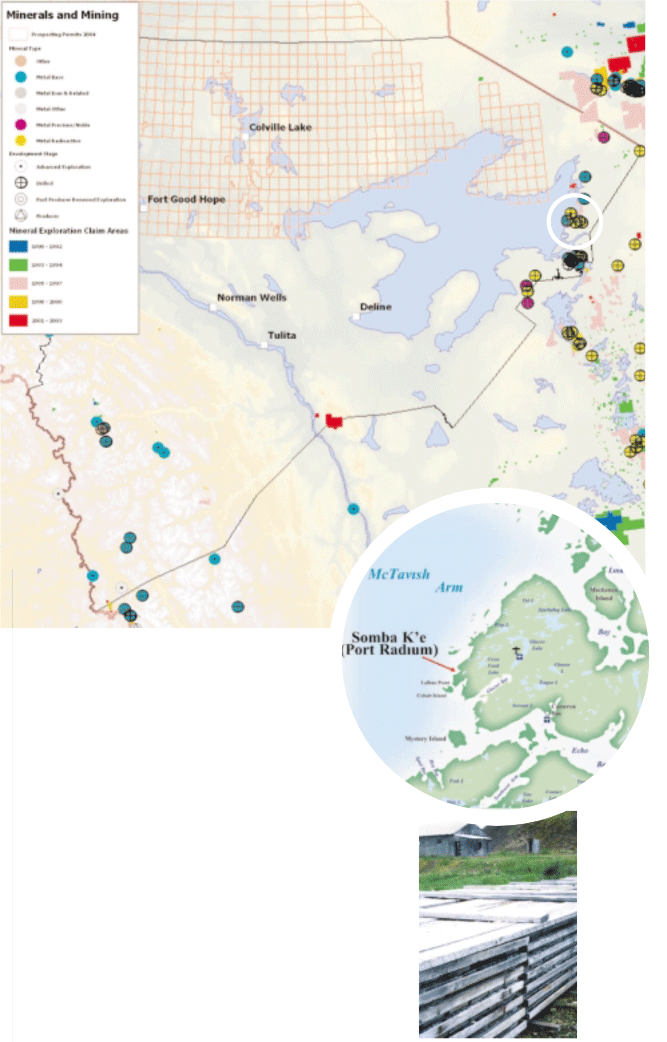Minerals and mining, Port Radium
Uranium And The Sahtúot'ine
In 1930, prospectors found pitch blend radium and uranium at Great Bear Lake. At first, the main interest was in the radium used for medical purposes. But when the lethal use of uranium was discovered, the Sǫmba K'e (Port Radium) mine was secretly transferred to the Canadian government.
The uranium ore from Great Bear Lake was refined at Port Hope, Ontario, and from there went directly to the Manhattan Project to make an atomic bomb. After the destruction of Hiroshima and Nagasaki, Great Bear Lake uranium ore was sent to the United States for the construction of more bombs.
At its inception, the mine employed few Dene workers. The new demand for uranium led to the employment of Dene people. Many Sahtúot’ine worked as ore carriers, loggers and suppliers of country food for mine employees. Some moved their families close to the mine. The ore had to be transported in 100-pound bags down the Great Bear River by barge, then portaged by truck at the rapids and loaded onto another boat.
At every stop, the bags had to be loaded and unloaded on the backs of the ore carriers. And every time it was handled, the powdery ore would leak from the bags. An estimated 1.7 million tonnes of radioactive tailings were left behind at the mine site when the mine closed down.
The workers and families were not told about the risks from exposure to uranium ore, nor about its connection to the bombing of Hiroshima and Nagasaki. In an effort to make amends, a delegation of Dene people attended the peace ceremonies at Hiroshima in 1998 on the anniversary of the bombing. Bella Modeste was a member of that delegation: "We Dene people are a good people… We hope that blame won't be put on us because we had no knowledge about all that happened in the war."
Deline continues to research the impact of radiation on the environment and the people who lived there.

old core boxes, Port Radium
The Money Place
Dene elders knew about the strange substance at what later became known to them as "the money place," Sǫmba K’oe, long before they showed it to the white men who claimed to have "discovered" it. For the Sahtúot’ine, this has always been a powerful and dangerous place. George Blondin (1990:78-9) records an ancient story prophesying the grim legacy of Port Radium:
In the old days, the Sahtu Dene traveled across the lake to the Barrenlands every summer, to hunt caribou. Some of these Dene hunters were paddling near the shore on the east side of Sahtu (where Port Radium is today) and they came to a place where rocky cliffs rise high over the water. Like all Dene, they believed it was bad medicine to pass in front of this rock: it was said that loud noises came from within it. These particular hunters pulled their canoes out of the water, but decided not to portage...instead they camped near the cliff. During the night everybody was awakened by the singing of the medicine man... In the morning, when the medicine man stopped singing the people at last spoke to him... "Why did you sing all night...?"
"I foresaw many things and I was disturbed," replied the medicine man... The medicine man told them of his strange vision. "I saw people going into a big hole in the ground –strange people, not Dene. Their skin was white ... [and] they were going into a hole with all kinds of ... tools and machines... On the surface where they lived, there were strange houses with smoke coming out of them... I saw ... big boats with smoke coming out of them, going back and forth on the river. And I saw a flying bird – a big one. They were loading it with things...." "I watched them and finally saw what they were making with whatever they were digging out of the hole – it was something long, like a stick. I wanted to know what it was for – I saw what harm it would do when the big bird dropped this thing on people – they all died from this long stick, which burned everyone... But it isn't for now; it's a long time in the future. It will come after we are all dead."
From Sahtu Heritage Places and Sites Joint Working Group, Rakekée Gok’é Godi: Places We Take Care Of.
[ Sahtu Atlas Table of Contents ]
[ Next Section ]



 Phone: 867-374-4040
Phone: 867-374-4040 Email:
Email: